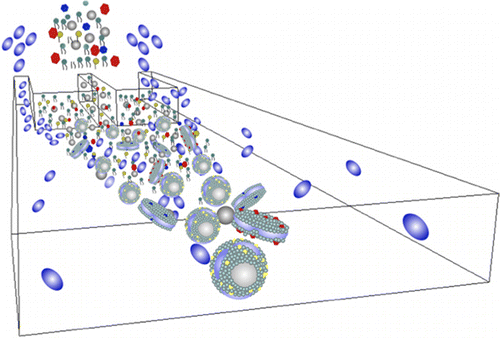A mimic of 'good cholesterol' could someday treat cardiovascular and other diseases

A new type of "good cholesterol," made in the lab, could one day deliver drugs to where they are needed in the body to treat disease or be used in medical imaging, according to scientists. Their report on the high-density lipoprotein (HDL) mimic, which is easy to make in large amounts, appears in the journal ACS Nano.
Zahi A. Fayad, Robert Langer, YongTae (Tony) Kim, Francois Fay, Willem Mulder and colleagues explain that HDL is a natural nanoparticle that carries cholesterol throughout the body. Because it acts like a scavenger, collecting cholesterol and taking it to the liver for breakdown, HDL has emerged from being simply a marker for cardiovascular disease—the number one killer of men and women in America—to being a therapeutic agent. Clinical trials are testing its potential to combat atherosclerosis, the build-up of plaques in blood vessels that can lead to heart attacks or strokes. Scientists are also exploring new ways to use it for drug delivery. But HDL is complex and comes in many varieties. It takes several labor-intensive steps to get a uniform collection of these particles with current methods, which aren't easily scaled up for clinical applications. That's why Fayad and Langer's groups devised a new and improved method for making HDL-like particles.
The scientists showed that microfluidics—the same technology that enabled the invention of inkjet printers—allowed them to make material called µHDL that looks and acts like HDL in a single, rapid step. Not only does this material offer a possible, easy new way to treat cardiovascular disease, but the researchers also attached drug compounds, as well as dyes and nanocrystals used in medical imaging (such as those used for MRIs and CT scans), to the particles.
More information: "Single Step Reconstitution of Multifunctional High-Density Lipoprotein-Derived Nanomaterials Using Microfluidics" ACS Nano, Article ASAP. DOI: 10.1021/nn4039063
Abstract
High-density lipoprotein (HDL) is a natural nanoparticle that transports peripheral cholesterol to the liver. Reconstituted high-density lipoprotein (rHDL) exhibits antiatherothrombotic properties and is being considered as a natural treatment for cardiovascular diseases. Furthermore, HDL nanoparticle platforms have been created for targeted delivery of therapeutic and diagnostic agents. The current methods for HDL reconstitution involve lengthy procedures that are challenging to scale up. A central need in the synthesis of rHDL, and multifunctional nanomaterials in general, is to establish large-scale production of reproducible and homogeneous batches in a simple and efficient fashion. Here, we present a large-scale microfluidics-based manufacturing method for single-step synthesis of HDL-mimicking nanomaterials (μHDL). μHDL is shown to have the same properties (e.g., size, morphology, bioactivity) as conventionally reconstituted HDL and native HDL. In addition, we were able to incorporate simvastatin (a hydrophobic drug) into μHDL, as well as gold, iron oxide, quantum dot nanocrystals or fluorophores to enable its detection by computed tomography (CT), magnetic resonance imaging (MRI), or fluorescence microscopy, respectively. Our approach may contribute to effective development and optimization of lipoprotein-based nanomaterials for medical imaging and drug delivery.
Journal information: ACS Nano
Provided by American Chemical Society















